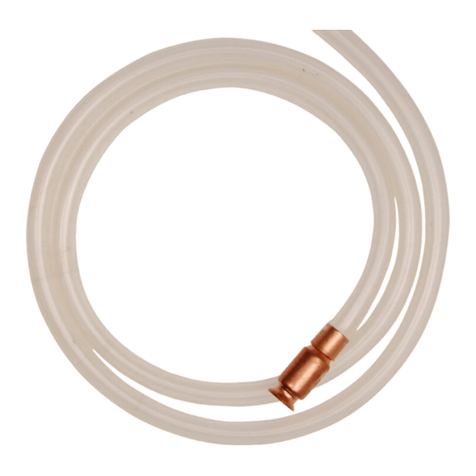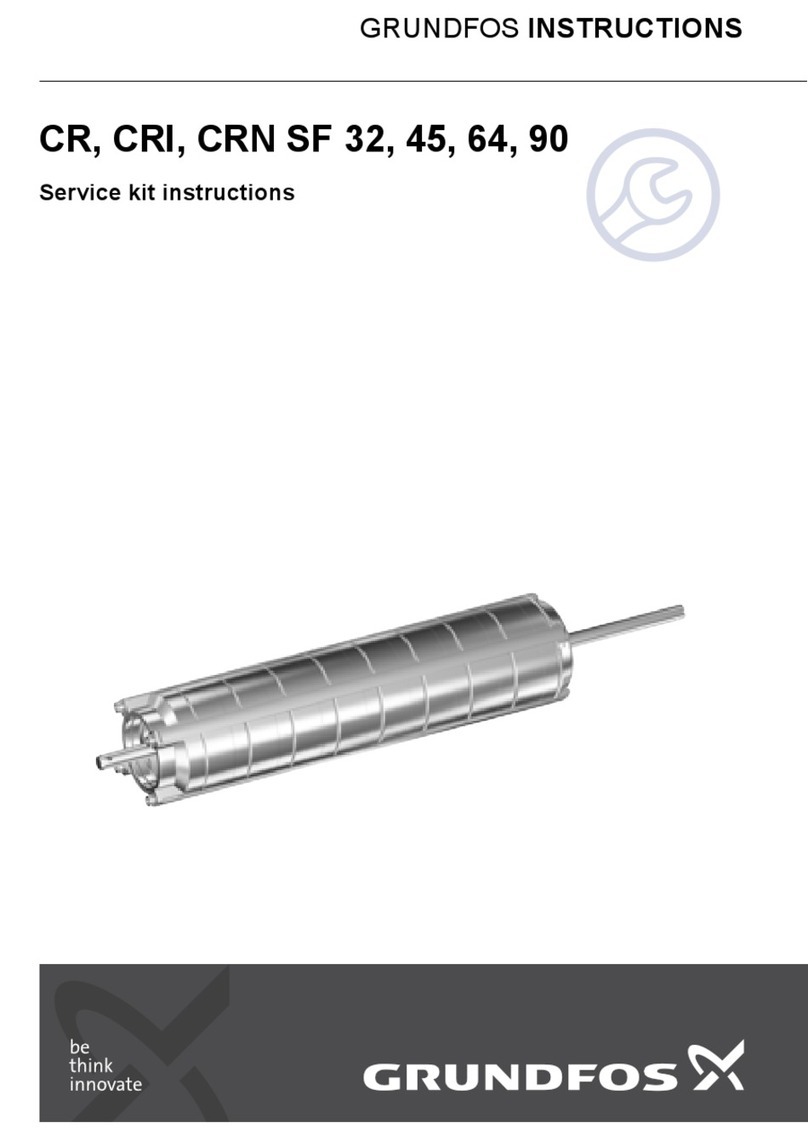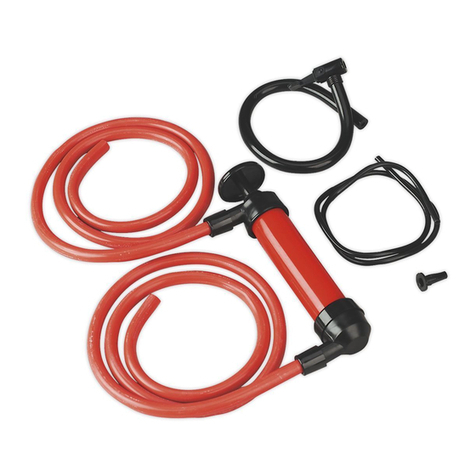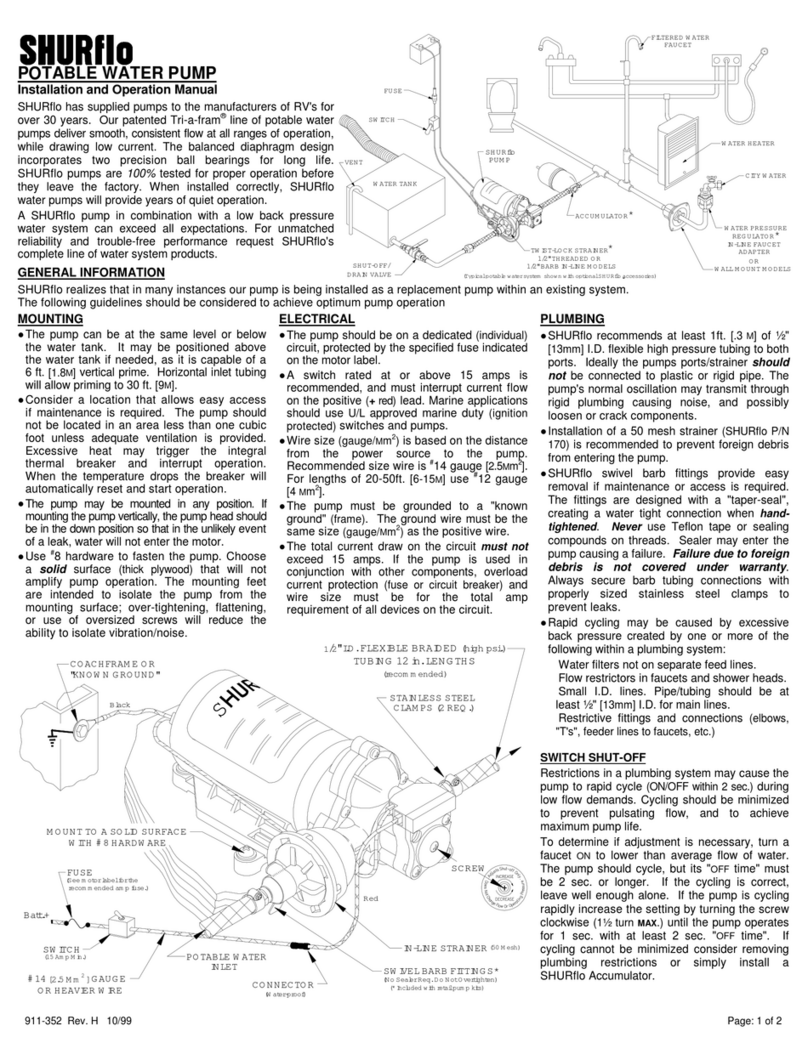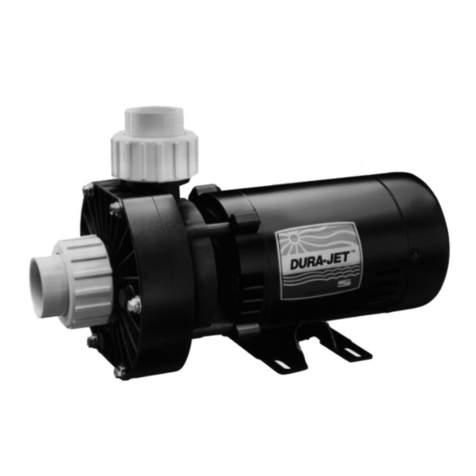Grifo G20 User manual

INSTRUCTIONS MANUAL
BIDIRECTIONAL SELFPRIMING

Overall dimensions
Mod.
G20
G25
G30
G20I
G20I95°
A (mm)
230
250
310
230
230
B (mm)
120
120
150
120
120
H (mm)
190
190
210
190
190
H
Technical specifications
Model
Unità
G20
G25
G30
G20I
G20I95°
Connection
income/outcome
-
¾”
1”
1 ¼”
¾”
¾”
Delivery
l/min
28
41
75
28
28
Lift
m
25
25
20
25
25
Power
Hp
0,5
0,8
1,0
0,5
0,5
Revolutions of the engine
Rpm
2850
2850
2800
2850
2850
Protection of the engine
IP
44
44
44
44
44
Net voltage
V
230
230
230
230
230
Net frequency
Hz
50
50
50
50
50
Condenser
8 uF
400V
8 uF
400V
8 uF
400V
8 uF 400V
8 uF
400V
Noise level
dB(A)
< 80
< 80
< 80
< 80
< 80
Minimal liquid
temperature
°C
+5° C
+5° C
+5° C
+5° C
+5° C
Maximal liquid
temperature
°C
+35° C
+35° C
+35° C
+35° C
+95° C
Weight
Kg
5
6
8
5
5
A
B

Description
All the transfer pumps are guaranteed as execution, as used materials and provide the performances, when
they are correctly used and subjected to maintenance, following the instructions given.
All products are covered by a one-year warranty starting from the date of shipment of the material.
This is the classic self-suction liquid ring auto suction pump with a star-shaped impeller.
This hydraulic system gives it an extraordinary self-priming capacity, even in the presence of a discontinuous
availability of the liquid to be transferred to the intake (due to the presence of air or other gases).
They are very reliable, self-priming and / or self-sucking electric pumps, easy to clean and guarantee strict
transfer requirements. They find application where corrosion conditions do not require the use of an acid-
resistant pump. All components have undergone a protective surface treatment.
The distinguishing feature is that the pumps are equipped with an electric switch, which makes the direction
of rotation of the motor "bisense", that is possible in both directions of clockwise or counterclockwise rotation.
The purpose of the use and maintenance regulations is to pay attention to the safety of persons and the
absence of damage to the surrounding environment.
This safety depends on the correct installation, maintenance and correct use.
The electric pump is supplied in resistant packaging with instruction booklet, ready for installation. After
removing it from the packaging, check the integrity and for any anomaly, contact the supplier, reporting the
defect. Before proceeding with the installation, read this documentation and the attachment carefully.
Installation and operation must comply with the safety rules of the product installation country.
Failure to comply with safety regulations, in addition to creating danger to the safety of people and damage
to equipment, will result in the loss of any right to intervention under warranty. The booklet must be read
carefully by all the people who are going to work with the pump, it must be kept for the entire life cycle of the
pump in a protected place and near the pump itself.
Main components and accessories
In the electropump is composed of a mechanics system a hydraulics section and an electric system.
The main parts are:
•Electro engine energy ➔it transforms the electric energy into mechanic
•Pumping section ➔it carries the liquid
•Filler ➔it allows the connection of the pump
Usage field
The electric pump must only be used for surface decanting; it is absolutely not suitable for submerged uses
(with underwater electric motor).
The pump is a device that can be a source of danger for: children and elderly or disabled people and during
the use of the pump these categories of people cannot be left unattended.
It is used only for aspiration, decanting or distribution of liquids without impurities and in particular low
viscosity (<28 cSt).
The liquids to be transferred must be neutral and clean, or contain in suspension only small percentages
(0.4% max) of solid particles that are not able to easily wear out the internal surfaces of the pump.
In extreme cases it is good practice to install a narrow mesh filter on the suction pipe.
Do not use the electric pump for decanting in tropical environments or with corrosive or explosive
atmospheres (dust, vapors or other gases). In this case, special measures will be required which must be
requested from the manufacturer. The pump motor is designed for continuous duty operation during which
no broadcasting and / or electromechanical television disturbances are generated.
WARNING! The use of the pump with solvents, petrol and concentrated acids is prohibited.
GB

Usage control
•Read the manual carefully before starting to use the pump.
•Do not use the machine to suck or pump liquids or substances other than those indicated in the
section Field of use.
•Only operate the self-priming self-priming pump when you are certain that the flow of treated liquid is
directed towards a container that collects it.
•Take special care not to direct the jet at people or things, dispensing liquids on electrical panels or
live electrical components exposes you to the danger of electrocution.
•Always position the electric pump so that the start switch cannot be operated accidentally.
•Remove the plug from the mains after each use.
•Do not modify any part of the pump in order not to compromise the safety of the operator and the
validity of the guarantee.
•In the event of component or pipe breakage, ensure that the liquid does not leak into the
environment.
•Repairs must be carried out only with original spare parts.
•For safety reasons, the operator must limit himself to simple control and reduced routine
maintenance, while for the repair or replacement of components it is necessary to contact our
service centers. By directly intervening, the guarantee is lost and exposes you to insecure and
potentially dangerous operations.
PAY ATTENTION! Do not use the pump if you are not sure how to use it. Do not modify or change
some components while it is power supplied.
Starting device
This device is located in the upper part of the electric motor, in a sturdy box that can effectively withstand
accidental impacts. The switch determines the correct direction of rotation of the pump based on the position
of the suction pipe, connected to the filler (flow reversal). The direction of rotation of the pump or the rest
condition is obtained by choosing one of the three available positions:
Pos. 0 = rest position (open circuit): the pump is deactivated.
Pos. 1 = clockwise rotation of the pump (closed circuit): the liquid outlet takes place from the left union.
Pos. 2 = counterclockwise rotation of the pump (closed circuit): the liquid outlet is from the right union.
NM: the filler is considered right or left in reference to the front view of the pump.
Do not intervene directly on the switch with sweaty or wet hands, because in the presence of invisible
lesions, it could cause electric shock. Should the pump stop during use, switch off the motor before any
intervention.
Choice and connection of the incoming feeder
•Use incoming feeders with 3 x 1 mm2section
•Use best quality incoming feeders type H5 –VVF or similar
•Do not damage the feeders stepping on it with cars or equipment
•Avoid the passage of the feeders on wet floor.
The integrity of the feeders must be controlled before the usage. If damaged or with abrasion, please change
it.
PAY ATTENTION! The incoming feeder can be substitute only by authorized staff or by the producer.
Electric connection
•Before any connection, be sure the net voltage is the same of the one written on the plate of the
electro pump.
•Connect the incoming feeder to the intake having all the safety standards.
PAY ATTENTION! Install the pump following all the safety standards. If not qualified, we suggest you
to ask for an authorized installer.

Starting and self priming effect
Before start the pump, fill up the body of the pump with liquid to facilitate the self priming. Start the engine.
After 30 seconds, if the self priming does not begin, stop the pump and check the presence of air in the pipe.
The tightening of hose clamps and pipe unions must be controlled frequently. The suction pipe must be stiff
or spiraled, in order to avoid the depression, caused by the working pump, to crush it.
When the pump us used in a depth of 3 meters (and upper) we suggest you to use a foot or check valve.
During the usage, the pump must be placed the nearest to the spring of the pumped liquid. Do not use the
pump without liquid (inside the body of the pump). The pump must always work in a horizontal position,
during the selpriming and pouring off phase. When the pump be used for long periods, we suggest you to fix
it on the horizontal surface.
PAY ATTENTION! Please check if the suction pipe is free from obstructions, not bent or crushed and
completely plunged in the liquid.
Handling
•To store and transport a new pump, does not request particular attentions. Be sure the voltage is off
before any intervention. Remember to use the given accessories for the transport of the pump.
•The weight and size of the pump are shown on page 5 and 6.
•The pump is pre-assembled, ready to be used and packed in order to avoid any damage during the
transport.
•The package must be disposed of carefully.
•If after the usage of the pump, it must be transported, you have to empty the body of the pump and
the suction/delivery pipe unions in order to avoid any leakage of liquid during the transport.
•During this operation you must use glove and safety shoes.
•Liquids must be poured in right recipients be disposed of carefully.

Maintenance
For any modification not authorize, the producer is not liable. All the motioning parts are pre-lubricated in the
factory. Never use oils or greases on the motioning parts, they might be damaged. All the spare parts and
accessories used during the reparation must be original and authorized by the producer in order to have the
highest safety during the working process.
If the pump is used wrongly with corrosive liquids, it must be cleaned and used with clean water. If used with
temperatures below 4C°, to avoid the presence of ice inside the pump, please empty it before put it away.
If not used for long periods, please protect it especially the engine.
Anomalies and remedies
In the following layout you can find the most frequent problems that can be resolved with an accurate
maintenance.
FAULTS
CUASES
REMEDIES
The engine doesn’t
start
There is no Voltage
Cotnrol fuses, the presence of loosen contacts
and verify the voltage
There is no Voltage
Remove the cover of the pump and clean the
impeller
The condenser is ineffective
Replace the component
The engine works, but
there’s no pumping
effect
The foot valve is stopped up
Clean or replace the valve
Excessive high of suction
Move the pump closed to the static level of the
liquid
Presence of air during the
suction
Verify the tightening of hose clamps. The suction
pipe must be soaked in the liquid and connected
exactly with the suctioning pipe union.
The rotation sense of the
impeller is not correct
In the single phase engine change the rotation
sense usign the switch
The delivery is
reduced
Occlusion of the valve or
filter of suction
Clean or replace the valve or filter, if necessary
all the suction pipe
The impeller is obstructed
Clean the pumping section
The thermo probe is
on
Excessive overheating of the
electric engine
Verify voltage and ventilation
The pumped liquid is too thick
The impeller is locked
Unlock the impeller. Use a filter in the suction.
The electric engine is
damaged
Ask for an authorized staff
Please note: if problems persist, ask for the producer help.

Esplosi e ricambi
DE -
ZEICHNUNG EINER AUSEINANDER GEBAUTEN PUMPE, UM DIE IDENTIFIKATION DER
ERSATZTEILE ZU ERLEICHTERN
A) 1.Deckelschraube, 2. Raddeckel, 3. OR-Ring, 4. Hydraulikrad, 5. gekrümmte Gummihalterung, 6. gerade
Gummihalterung, 7. Dichtung der Gummihalterung, 8. Gewindering der Gummihalterung, 9. Pumpenkörper, 10.
Dichtungsring, 11. Herausdreh-Sperrmutter des Pumpenkörpers, 12. Dichtung aus Gewebegummi, 13. Motorflansch, 14.
Welle mit Läufer und Lagern, 15. Motorkasten mit Stator, 16. Umschalter, 17. Grundgestell-Kabelkasten, 18. Kondensator,
19. Deckel-Kabelkasten, 20. Motorschild, 21. Kühllüfter, 22. Lüfterdeckel, 23. Motorzugstange, 24. Kabel mit Schuko -
Stecker und Temperaturmotorschutzschalter, 25. Sicherheitsschraube, 26. Herausdreh-Sperrschraube, 27. Herausdreh-
Sperrmutter des Motors.
B) 1.Deckelschraube, 2. Raddeckel, 3. OR-Ring, 4. Hydraulikrad, 5. gekrümmte Gummihalterung, 6. gerade
Gummihalterung, 7. Dichtung der Gummihalterung, 8. Gewindering der Gummihalterung, 9. Pumpenkörper, 10.
Dichtungsring, 11. Herausdreh-Sperrmutter des Pumpenkörpers, 12. Dichtung aus Gewebegummi, 13. Pumpenhalterung,
14. Welle mit Lagern, 15. Keil, 16. Seeger-Ring, 17. Ausgleichsring, 18. Riemenscheibe.
EL - ΣΧΈΔΙΟ ΛΥΜΈΝΗΣ ΑΝΤΛΊΑΣ, ΓΙΑ ΤΟΝ ΕΎΚΟΛΟ ΕΝΤΟΠΙΣΜΌ ΤΩΝ ΑΝΤΑΛΛΑΚΤΙΚΏΝ
A) 1.Βίδα καπακιού, 2. Καπάκι φτερωτής, 3. Δαχτυλίδι Ο-ρινγκ, 4. Υδραυλική φτερωτή, 5. Κυρτό ρακόρ σωλήνα, 6.
Ίσιο ρακόρ σωλήνα, 7. Φλάντζα ρακόρ σωλήνα, 8. Ρυθμιστική ροδέλα ρακόρ σωλήνα, 9. Σώμα αντλίας, 10. Τσιμούχα, 11.
Ασφαλιστικό παξιμάδι σώματος αντλίας, 12. Φλάντζα λάστιχου κεφαλής, 13. Φλάντζα κινητήρα, 14. Άξονας με στροφείο
και ρουλεμάν, 15. Κέλυφος κινητήρια με στάτη, 16, Μεταγωγέας, 17. Κιβώτιο καλωδιώσεων-βάσης, 18. Πυκνωτής, 19.
Κιβώτιο καλωδιώσεων-καπακιού, 20. Μάσκα κινητήρα, 21. Ανεμιστήρας ψύξης, 22. Κάλυμμα ανεμιστήρα, 23. Ελκυστήρας
κινητήρα, 24. Καλώδιο με φις Σούκο και θερμική ασφάλεια κινητήρα, 25. Ασφαλιστική βίδα, 26. Αντιστρεπτική βίδα, 27.
Ασφαλιστικό παξιμάδι κινητήρα.
B) 1.Βίδα καπακιού, 2. Καπάκι φτερωτής, 3. Δαχτυλίδι Ο-ρινγκ, 4. Υδραυλική φτερωτή, 5. Κυρτό ρακόρ σωλήνα, 6.
Ίσιο ρακόρ σωλήνα, 7. Φλάντζα ρακόρ σωλήνα, 8. Ρυθμιστική ροδέλα ρακόρ σωλήνα, 9. Σώμα αντλίας, 10. Τσιμούχα, 11.
Ασφαλιστικό παξιμάδι σώματος αντλίας, 12. Φλάντζα λάστιχου κεφαλής, 13. Έδρανο αντλίας, 14. Άξονα με ρουλεμάν, 15.
Σφήνα διαμήκης, 16. Ασφάλεια seeger, 17. Δαχτυλίδι εξισορρόπησης, 18. Τροχαλία.
ES - DISEÑO DE DESPIEZO DE LA BOMBA PARA FACILITAR LA IDENTIFICACIÓN DE LAS PARTES
DE RECAMBIO
A) 1.Tornillo tapa, 2.Tapa rodete, 3.Anillo OR, 4.Rodete hidráulico, 5.Portagoma curvada, 6.Portagoma recta,
7.Junta portagoma, 8.Anillo portagoma, 9.Cuerpo bomba, 10.Retén, 11.Tuerca antidestornillamiento cuerpo bomba,
12.Junta goma tela, 13.Brida motor, 14.Eje con rotor, y cojinetes, 15.Caja motor con estator, 16.Conmutador, 17.Caja
cableados-base, 18.Condensador, 19.Caja cableados-tapa, 22.Pantalla motor, 21.Ventiladorde enfriamiento, 22.Protector

ventilador, 23.Tirante motor, 24.Cable con clavija Schuko y cortacircuito térmico, 25.Tornillos de seguridad, 26.Tornillos
antidestornillamiento, 27.Tuerca antidestornillamiento motor.
B) 1.Tornillo tapa, 2.Tapa rodete, 3.Anillo OR, 4.Rodete hidráulico, 5.Portagoma curvada, 6.Portagoma recta,
7.Junta portagoma, 8.Anillo portagoma, 9.Cuerpo bomba, 10.Retén, 11.Tuerca antidestornillamiento cuerpo bomba,
12.Junta goma tela, 13.Soporte bomba, 14.Eje con cojinetes, 15.Clavija, 16.Anillo Seeger, 17.Anillo compensador,
18.Polea
FR –DESSIN D’UNE POMPE DÉMONTÉE POUR FACILITER L’IDENTIFICATION DES PIÈCES DE
RECHANGE
A) 1. Vis couvercle, 2. Couvercle turbine, 3. Joint torique, 4. Turbine hydraulique, 5. Embout courbé, 6. Embout droit,
7. Joint embout, 8. Douille embout, 9. Corps pompe, 10. Anneau de tenue, 11. Ecrou de sûreté corps pompe, 12. Joint en
caoutchouc toilé, 13. Bride moteur, 14. Arbre avec rotor et roulements à billes, 15. Caisson moteur avec stator, 16.
Commutateur, 17. Boîtier câblages-base, 18. Condensateur, 19. Boîtier câblages-couvercle, 22. Bouclier moteur, 21.
Ventilateur de refroidissement, 22. Capot de ventilateur, 23. Tirant moteur, 24. Câble avec prise Schuko et coupe-circuit
thermique, 25. Vis de sécurité, 26. Vis de sûreté, 27. Ecrou de sûreté moteur.
B) 1. Vis couvercle, 2. Couvercle turbine, 3. Joint torique, 4. Turbine hydraulique, 5. Embout courbé, 6. Embout droit,
7. Joint embout, 8. Douille embout, 9. Corps pompe, 10. Anneau de tenue, 11. Ecrou de sûreté corps pompe, 12. Joint en
caoutchouc toilé, 13.Support pompe, 14. Arbre avec roulements à billes, 15. Petite clef, 16. Anneau Seeger, 17. Anneau
de compensation, 18. Poulie.
GB - ILLUSTRATION OF DISMANTLED PUMP FOR EASIER IDENTIFICATION OF SPARE PARTS
A) 1.Cover screw, 2. Impeller cover, 3. OR ring, 4. Hydraulic impeller, 5. Curved hose adapter, 6.Straight hose adapter, 7.
Hose adapter seal, 8. Hose adapter ring nut, 9. Pump body, 10. Retention ring, 11. Pump body anti-unscrew screw nut,
12. Rubberised fabric seal, 13. Motor flange, 14. Shaft with rotor, and bearings, 15. Motor casing with stator, 16. Switch,
17. Basic cable box, 18.Capacitor, 19. Cover for cable box, 22. Motor shield, 21. Cooling fan, 22. Fan cover, 23. Motor rod,
24. Cable with plug and thermal overload cutout, 25. Safety screws, 26. Anti-unscrew screws, 27.Motor anti-unscrew nut.
B) 1.Cover screws, 2. Impeller cover, 3. O ring, 4. Hydraulic impeller, 5. Curved hose adapter, 6.Straight hose adapter, 7.
Hose adapter seal, 8. Hose adapter ring nut, 9. Pump body, 10. Sealing ring, 11. Pump body anti-unscrew screw nut, 12.
Rubberised fabric seal, 13.Pump support, 14. Shaft with bearings, 15. Key, 16. Seeger ring, 17. Compensation ring, 18.
Pulley
IT - DISEGNO DI POMPA SCOMPOSTA PER FACILITARE L'IDENTIFICAZIONE DELLE PARTI DI
RICAMBIO
A)1.Vite coperchio, 2.Coperchio girante, 3.Anello OR, 4.Girante Idraulica, 5.Portagomma curvo, 6.Portagomma dritto,
7.Guarnizione portagomma, 8.Ghiera portagomma, 9.Corpo pompa, 10.Anello di tenuta, 11.Dado antisvitamento corpo
pompa, 12.Guarnizione gomma telata, 13.Flangia motore, 14.Albero con rotore, e cuscinetti, 15.Cassa motore con statore,
16.Commutatore, 17.Scatola cablaggi-base, 18.Condensatore, 19.Scatola cablaggi-coperchio, 22.Scudo motore,
21.Ventola di raffreddamento, 22.Copriventola, 23.Tirante motore, 24.Cavo con spina Schuko e salvamotore termico,
25.Vite di sicurezza, 26.Viteantisvitamento, 27.Dado antisvitamento motore.
B)1.Vite coperchio, 2.Coperchio girante, 3.Anello OR, 4.Girante Idraulica, 5.Portagomma curvo, 6.Portagomma dritto,
7.Guarnizione portagomma, 8.Ghiera portagomma, 9.Corpo pompa, 10.Anello di tenuta, 11.Dado antisvitamento corpo
pompa, 12.Guarnizione gomma telata, 13.Supporto pompa, 14.Albero con cuscinetti, 15.Chiavetta, 16.Anello Seeger,
17.Anello compensatore, 18Puleggia
PT - DESENHO DE BOMBA EXPLODIDO PARA FACILITAR A IDENTIFICAÇÃO DAS PEÇAS
SOBRESSELENTES
A) 1.Parafuso da tampa, 2.Tampa do impulsor, 3.Anel OR, 4.Impulsor Hidráulico, 5.Porta-tubo curvo, 6.Porta-tubo
recto, 7.Junta de vedação do porta-tubo, 8.Anel do porta-tubo 9.Corpo da bomba, 10.Anel de retenção, 11.Porca
antidesenroscamento do corpo da bomba, 12.Junta de vedação de borracha com tela, 13.Flange do motor, 14.Eixo com
rotor e manc ais, 15.Caixa do motor com estator, 16.Comutador, 17.Caixa de cablagens-base, 18.Condensador, 19.Caixa
de cablagens-tampa 22.Protector do motor 21.Ventoinha de arrefecimento, 22.Cobertura da ventoinha, 23.Tirante do
motor 24.Cabo com ficha Schuko e aparelho de protecção térmica do motor, 25.Parafuso de segurança, 26.Parafuso
antidesenroscamento, 27.Porca antidesenroscamento do motor.
B) 1.Parafuso da tampa, 2.Tampa do impulsor, 3.Anel OR, 4.Impulsor Hidráulico, 5.Porta-tubo curvo, 6.Porta-tubo
recto, 7.Junta de vedação do porta-tubo, 8.Anel do porta-tubo 9.Corpo da bomba, 10.Anel de retenção, 11.Porca
antidesenroscamento do corpo da bomba, 12.Junta de vedação de borracha com tela, 13.Suporte da bomba, 14.Eixo com
mancais, 15 .Chaveta, 16.Anel Seeger, 17.Anel compensador, 18.Polia.
SLO - NAČRT RAZSTAVLJENE ČRPALKE ZA LAŽJE IDENTIFICIRANJE REZERVNIH DELOV
A) 1.vijak pokrova, 2. pokrov obračajoče se osi, 3. obroček OR, 4. hidravlična obračajoča os, 5. ukrivljen nosilec
gume, 6. raven nosilec gume, 7.tesnilo nosilca gume, 8. kovinski obroč za nosilec gume, 9. osrednji del črpalke, 10. obroček
za pritrjevanje, 11. matica proti odvijanju srednjega dela črpalke, 12. tesnilo iz gume, pokrito s platnom, 13. prirobnica
motorja, 14. gred z rotorjem in ležaji, 15. ogrodje moto rja s statorjem, 16.komutator, 17. škatla za kable-osnovna, 18.
kondenzator, 19. škatla za kable-pokrov, 22. zaščita motorja, 21. loputa za ohlajevanje, 22. pokrov za loputo, 23. napenjalo
motorja, 24. kabel s šuko vtikačem in toplotnim samodejnim stikalom za motor, 25. varnostni vijak , 26. vijak proti odvijanju,
27. matica motorja proti odvijanju
B) 1. vijak pokrova, 2. pokrov obračajoče osi, 3. obroček OR, 4. hidravlična obračajoča os, 5. ukrivljen nosilec gume,
6. raven nosilec gume, 7. tesnilo nosilca gume, 8. kovinski obroč za nosilec gume, 9. osrednji del črpalke, 10. obroček za
pritrjevanje, 11. matica proti odvijanju srednjega dela črpalke, 12. tesnilo iz gume, pokrito s platnom, 13. ležišče črpalke,
14. gred z ležaji, 15. ključ, 16. obroček Seeger, 17. obroček kompenzator,
18.jermenica
Other manuals for G20
1
This manual suits for next models
4
Table of contents
Popular Water Pump manuals by other brands
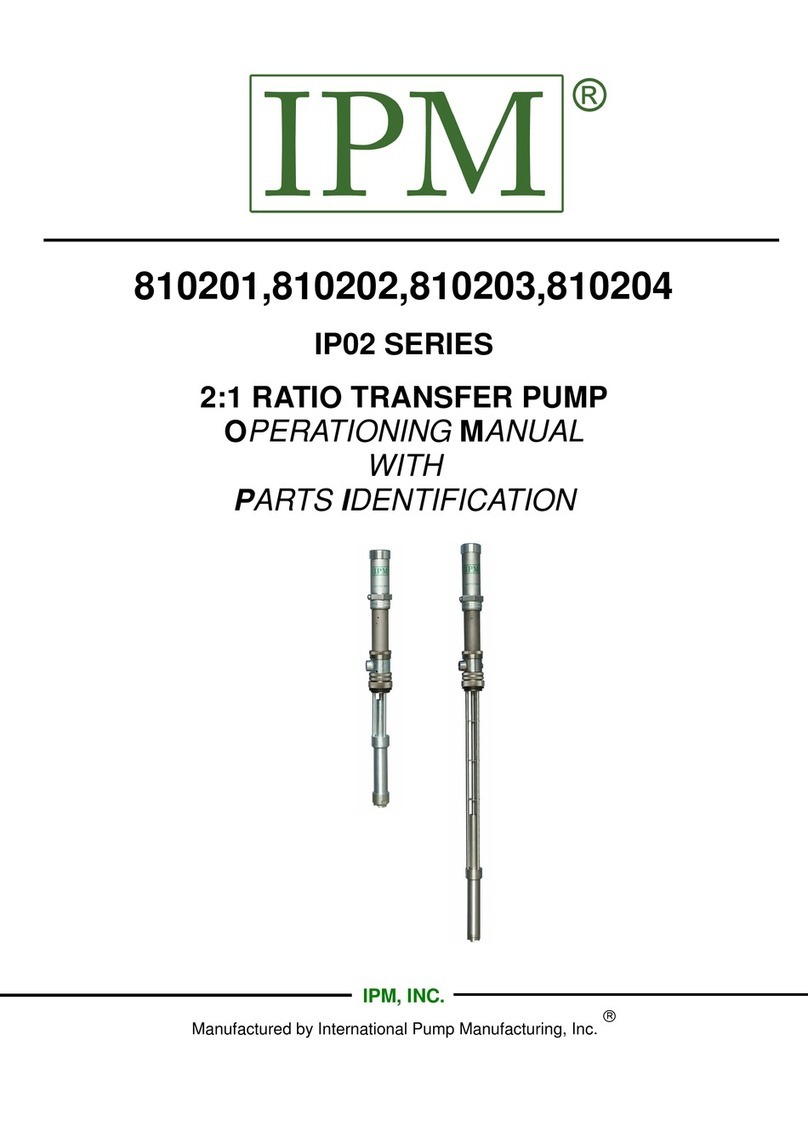
IPM
IPM IP02 Series OPERATIONING MANUAL WITH PARTS IDENTIFICATION

Speck pumpen
Speck pumpen Zismatic 40/08 WE translation of original operation manual
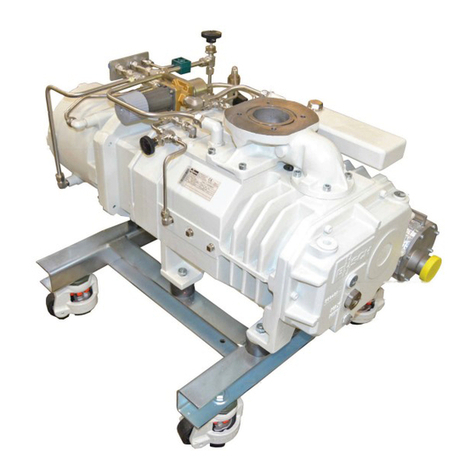
BUSCH
BUSCH COBRA NS 0070-0160 C Installation and maintenance instructions

IWAKI PUMPS
IWAKI PUMPS MDM Series instruction manual
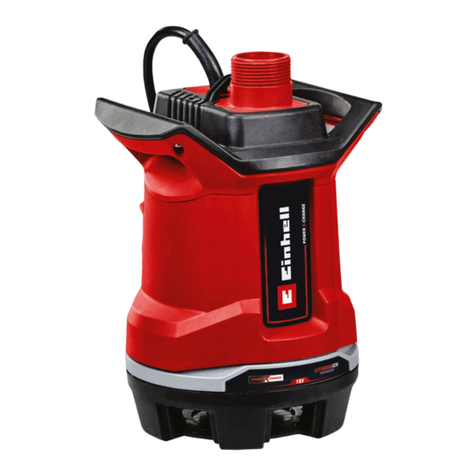
EINHELL
EINHELL GE-DP 18/25 Li Original operating instructions
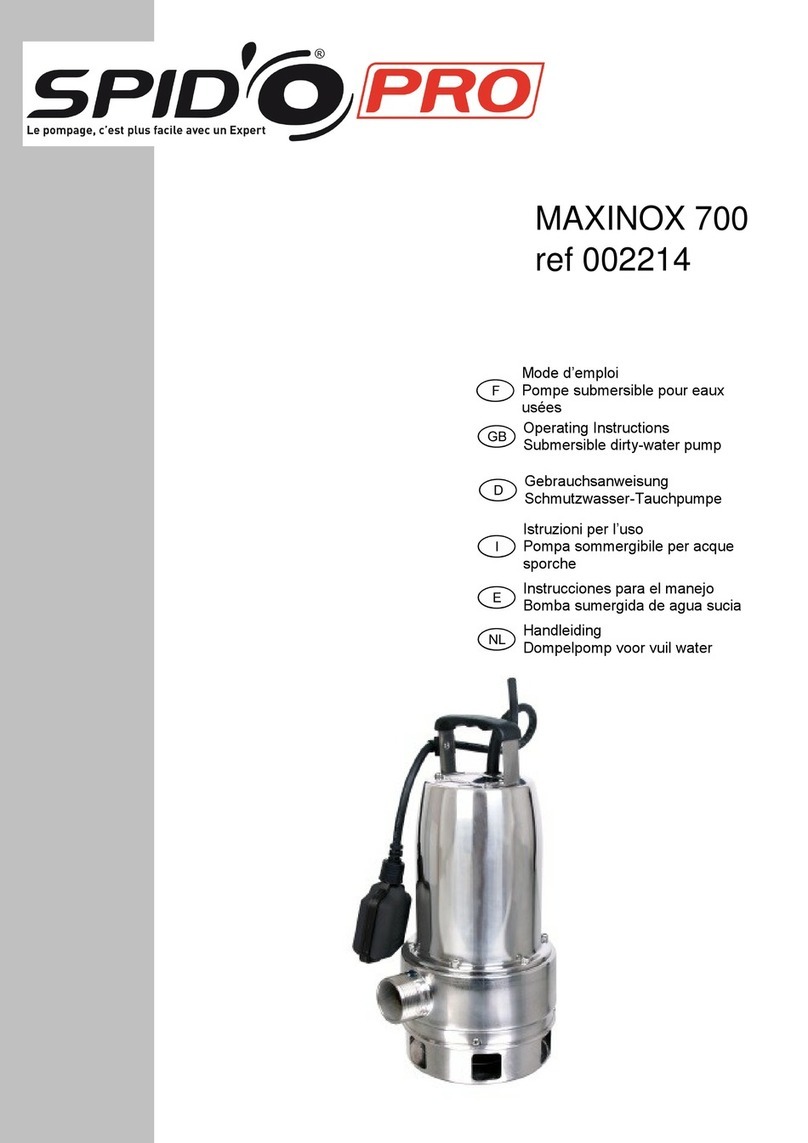
SPIDO
SPIDO PRO MAXINOX 700 operating instructions




